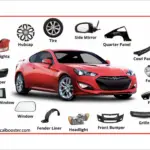The transmission is one of the most crucial components of your vehicle. You want to provide the proper maintenance and care to keep this part working correctly.
We’ve found seven ways to avoid transmission problems, so your car functions at peak conditions. Use these tips to prevent costly issues that could put a dent in your savings, cost you a lot of stress, and leave you stranded without a working vehicle.

1. Examine Fluids
One of the easiest ways to keep your transmission working right is to perform regular checks of your transmission’s fluids.
Get into the habit of checking your fluid levels every 1,000 miles. And you should perform a transmission fluid change every 50,000 miles; or every other year, whichever comes first.
And you can also take your vehicle to a mechanic to have your transmission flushed every two years or 30,000 miles.
2. Use the Proper Fluid
Some people may rush into a store, grab the first jug of transmission fluid they see and head to the register. But this isn’t the proper method to shop for your car’s fluids.
Different vehicles require different types of fluid. Newer vehicles may need newer brands of juice, which are usually more expensive.
But these transmission fluids usually have advanced components that can improve your transmission’s functionality and offer better protection.
3. Avoid Overfilling
When changing your transmission fluid or topping off the fluids when they’re low, you want to be sure you know how much liquid your car can hold. You can find this information on your vehicle’s owner’s manual or manufacturer’s website.
It can be damaging to your vehicle to overfill your transmission. When you add too much fluid, the fluid can form foam.
Foam can cause your transmission to shift erratically, lose internal lubrication, and potentially cause permanent damage to your transmission.
Also Read:
- How Automatic Transmission Works? – Best Explanation Ever
- What is CVT – Continuously Variable Transmission and How it Works?
- Types of Gearbox – Complete Explanation
4. Avoid Towing in Overdrive
If you use your vehicle for towing, it’s essential to keep your car out of Overdrive, which can put too much strain on your transmission, resulting in damage or failure.
All vehicles will have a button to turn Overdrive off. Where this button will be will vary by model and car. Some buttons will be on the steering column or the dash.
If you don’t see the button in one of these locations, it may be on your shift indicator. In this case, shift your vehicle from Overdrive, usually showing as OD on your dashboard or gear shift. You need to make sure your car is in Drive, indicated by a D.
5. Install a Cooler
Heat is a serious threat to your transmission’s overall health. Studies show that 90% of transmission problems occur due to heat exposure.
Keeping the heat off your transmission can improve the part’s functionality and extend the transmission’s lifespan.
Installing an auxiliary cooler can help reduce excess heat around your transmission. When towing, an auxiliary cooler can reduce your transmission’s heat emissions by 30% to 50%.
6. Keep The Weight Light
All vehicles have a max weight capacity that they are capable of handling. Trying to add more weight than your car should hold can cause strain on your transmission.
The more weight a vehicle has, the harder your transmission has to work to compensate. This extra work can negatively impact your transmission.
7. Don’t Drive Your Vehicle Cold.
Driving your vehicle without letting your engine warm-up can cause your transmission to struggle through shifts. These struggles can cause lasting damage to your transmission.
You should give your vehicle at least 30 seconds to warm up after cranking before you shift into gear and start driving. However, even then, you’ll need to take it easy not to shift too fast until your car’s fully warmed up.
Waiting for an extra two to five minutes gives the engine enough time to come to life, so shifting will be at normal operating functions. You’ll need to wait less time when it’s hot outside than in cold months.
In Closing
Follow these easy tips to keep your transmission working properly. Having to repair or replace a transmission can be expensive. And trying to drive with a transmission that’s acting up can be stressful, frustrating, and dangerous. The first thing you can do to ensure you don’t experience transmission problems is to start with a reputable used car. You can visit Echo Park and let them help you.








